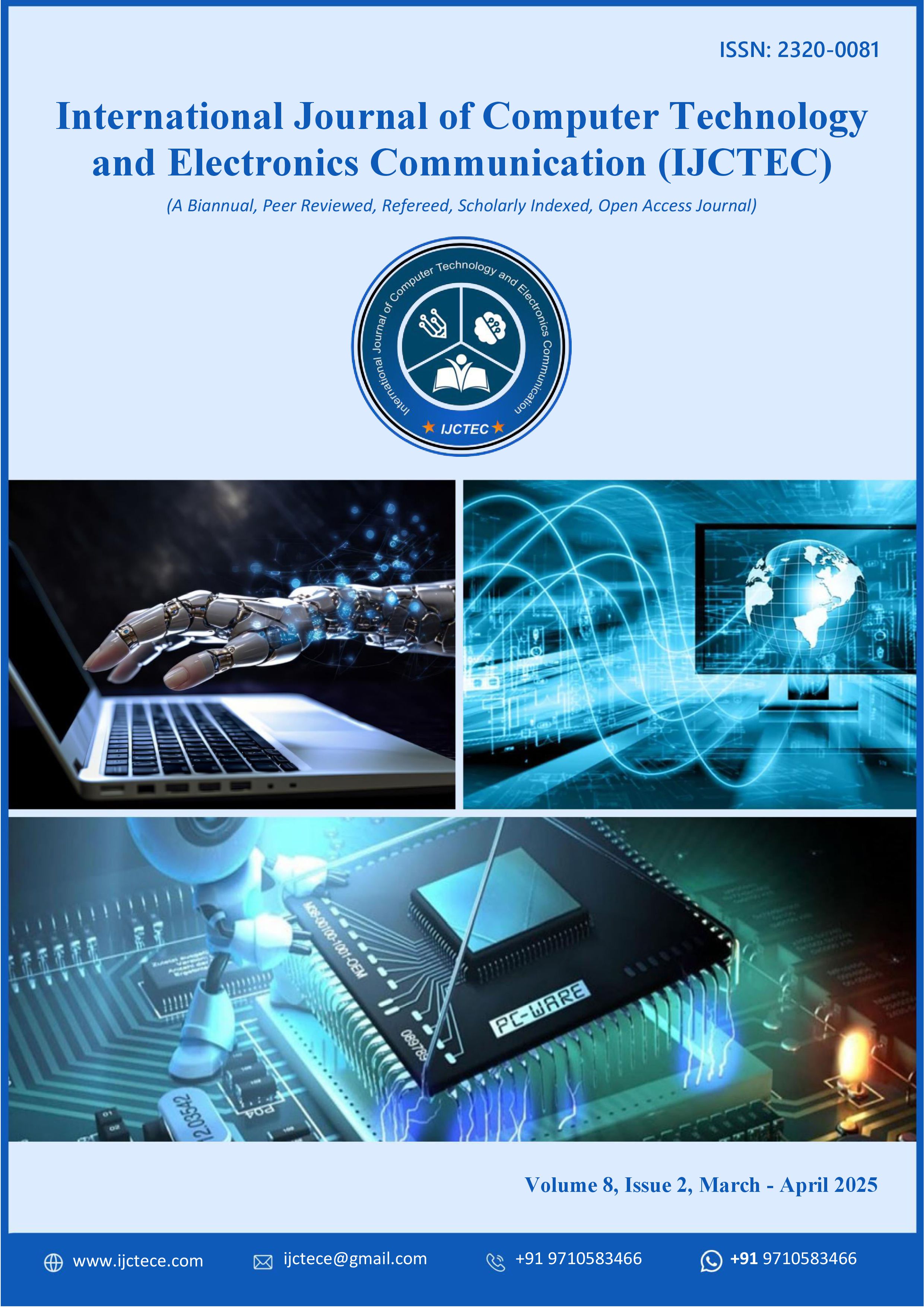Distributed Wireless Modular BMS for Fraud-Resilient Life Insurance Ecosystems Using AI and Cloud
DOI:
https://doi.org/10.15680/IJCTECE.2025.0802007Keywords:
Distributed Wireless BMS, Fraud-Resilient Life Insurance, AI-Driven Analytics, Cloud Computing, Modular Architecture, Anomaly Detection, Predictive Risk Management, Human-Centric Monitoring, Intelligent Insurance EcosystemAbstract
This paper presents a Distributed Wireless Modular Building Management System (BMS) framework for fraud-resilient life insurance ecosystems leveraging AI and cloud computing. The proposed architecture integrates distributed wireless nodes, modular system components, and AI-driven analytics to monitor, detect, and mitigate fraudulent activities in real time. Cloud-based orchestration ensures scalability, secure data management, and seamless integration of heterogeneous system modules. By combining predictive modeling, anomaly detection, and adaptive decision-making, the framework enhances operational efficiency, reduces risks, and improves trustworthiness in life insurance operations. The approach supports human-centric oversight, continuous learning, and resilience against evolving cyber threats, enabling a secure and intelligent insurance ecosystem.
References
1. Panagiotis, K. (2024). Applications, Risks, and Ethical Challenges of Extended Reality Technologies in the Metaverse: A Comprehensive Review. arXiv preprint arXiv:2411.04508. https://arxiv.org/abs/2411.04508
2. Sangannagari, S. R. (2022). THE FUTURE OF AUTOMOTIVE INNOVATION: EXPLORING THE IN-VEHICLE SOFTWARE ECOSYSTEM AND DIGITAL VEHICLE PLATFORMS. International Journal of Research and Applied Innovations, 5(4), 7355-7367.
3. Multimodal AI Agents for Life Insurance Automation. (2023). Multimodal.dev. Retrieved from https://www.multimodal.dev/life-and-disability-insurance
4. Jampani, R., et al. (2018). Multi-Modal Deep Learning for Risk Assessment in Insurance. Journal of Artificial Intelligence Research, 62, 391–418.
5. Lin, T. (2024). The role of generative AI in proactive incident management: Transforming infrastructure operations. International Journal of Innovative Research in Science, Engineering and Technology, 13(12). https://doi.org/10.15680/IJIRSET.2024.1312014
6. Smith, A., & Lee, B. (2020). Cloud Computing Infrastructure for Scalable Insurance Platforms. International Journal of Cloud Computing, 9(3), 134–150.
7. Karvannan, R. (2024). ConsultPro Cloud Modernizing HR Services with Salesforce. International Journal of Technology, Management and Humanities, 10(01), 24-32.
8. Amuda, K. K., Kumbum, P. K., Adari, V. K., Chunduru, V. K., & Gonepally, S. (2021). Performance evaluation of wireless sensor networks using the wireless power management method. Journal of Computer Science Applications and Information Technology, 6(1), 1–9.
9. Nguyen, T., & Wang, H. (2021). AI and AR/VR in Insurance: Transforming Customer Engagement. Insurance Technology Review, 15(2), 75–90.
10. Venkata Surendra Reddy Narapareddy. (2023). MODULAR FOUNDATION OF A BLUEPRINT MODEL. International Journal of Engineering Technology Research & Management (IJETRM), 07(10), 59–67. https://doi.org/10.5281/zenodo.1554 7718.
11. Asgarian, A., Saha, R., Jakubovitz, D., & Peyre, J. (2023). AutoFraudNet: A multimodal network to detect fraud in the auto insurance industry. arXiv preprint arXiv:2301.07526. Retrieved from https://arxiv.org/abs/2301.07526
12. Konda, S. K. (2022). ENGINEERING RESILIENT INFRASTRUCTURE FOR BUILDING MANAGEMENT SYSTEMS: NETWORK RE-ARCHITECTURE AND DATABASE UPGRADE AT NESTLÉ PHX. International Journal of Research Publications in Engineering, Technology and Management (IJRPETM), 5(1), 6186-6201.
13. Chen, W., Lyu, H., Luo, J., & Xu, X. (2024). Harnessing GPT-4V(ision) for insurance: A preliminary exploration. arXiv preprint arXiv:2404.09690. Retrieved from https://arxiv.org/abs/2404.09690
14. Sankar Thambireddy. (2025). SAP BDC: Also Known as SAP Business Data Cloud is A Fully Managed SaaS Solution that Unifies and Govern SAP and Party Data. Journal of Computer Engineering and Technology (JCET), 8(1), 11-34.
15. Devaraj, S. M. (2023). AI and cloud for claims processing automation in property and casualty insurance. Zenodo. https://doi.org/10.5281/zenodo.14498802
16. Peddamukkula, P. K. (2024). Artificial Intelligence in Life Expectancy Prediction: A Paradigm Shift for Annuity Pricing and Risk Management. International Journal of Computer Technology and Electronics Communication, 7(5), 9447-9459.
17. Dave, B. L. (2023). Enhancing Vendor Collaboration via an Online Automated Application Platform. International Journal of Humanities and Information Technology, 5(02), 44-52.
18. Arjunan, T. (2024). A comparative study of deep neural networks and support vector machines for unsupervised anomaly detection in cloud computing environments. International Journal for Research in Applied Science and Engineering Technology, 12(9), 10-22214.
19. Azmi, S. K. (2022). Computational Knot Theory for Deadlock-Free Process Scheduling in Distributed IT Systems. Well Testing Journal, 31(1), 224-239.
20. Chunduru, V. K., Gonepally, S., Amuda, K. K., Kumbum, P. K., & Adari, V. K. (2022). Evaluation of human information processing: An overview for human-computer interaction using the EDAS method. SOJ Materials Science & Engineering, 9(1), 1–9.
21. Gan, C., Schwartz, J., Alter, S., Mrowca, D., Schrimpf, M., Traer, J., ... & Tenenbaum, J. B. (2020). ThreeDWorld: A platform for interactive multi-modal physical simulation. arXiv preprint arXiv:2007.04954. Retrieved from https://arxiv.org/abs/2007.04954
22. Hendriksen, M., Bleeker, M., Vakulenko, S., van Noord, N., & Kuiper, E. (2021). Extending CLIP for category-to-image retrieval in e-commerce. Proceedings of the IEEE/CVF International Conference on Computer Vision, 10654–10663. https://doi.org/10.1109/ICCV48922.2021.01045


